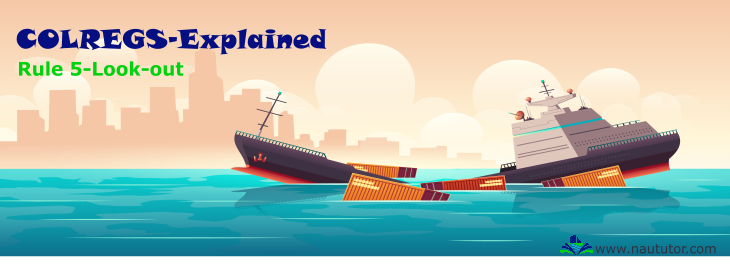Page Contents
COLREGS-International Regulations for Preventing Collisions at Sea Explained For Exams
Rule 5-Look-out explained
Before start reading the below topic make sure that you are familiar with the rules and important terms associated with the rules. if you don't; go to previous topics - ror-explained.
Firstly go through the rules,
Rule 5-Look-out
Every vessel shall at all times maintain a proper look-out by sight and hearing as well as by all available means appropriate in the prevailing circumstances and conditions so as to make a full appraisal of the situation and of the risk of collision.
Explanation of Rules
 Tips: We sorted important topics below, it will help you out in exams. good luck
Tips: We sorted important topics below, it will help you out in exams. good luck
- Lookout means to see and understand the situation, by sight and hearing as well as by all available means which may be by GPS (Position), Radar (Importance is high for this device), ECDIS, Radio and by any other electronic device.
- The purpose of the Lookout is to detect and, assess and manage the risk-especially Risk of Collision.
- If you were to be involved in a collision, the test as to a lookout is not just based on a person being aboard assigned to be a lookout; The test is based on if a person onboard is actually performing as
the lookout. If the answer to that test is no, then there is a clear violation of Rule 5 and therefore Rule 2. - You must pay attention to everything, not just looking ahead out of the bridge windows but looking all around the ship, using all your senses and all personal and equipment available to you.
- You must use all of the information- to assess the situation your vessel is in and the Risk of Collision.
- Appropriate in the prevailing circumstances means- in a condition of poor visibility, the radar and our ears are the only means of detecting other vessels.
- For the ships having two Radars, then one should be set to a smaller range and the other on a 12NM range for detecting other vessels.
- Periodic switches have to be done between a smaller scale and a longer scale for the ships having only one Radar.
- In any case, the following have to be also monitored. Because for a full appraisal of the situation all factors have to be taken into consideration.
- Echosounder
- The Log
- GPS
- Chart
- Vessel charted position
- Always remember that you are on bridge watch to keep the ship safe, as set out in Rule 2-responsibility.
Summary
Always keep a proper lookout.
Thank you,
By Team Naututor

Disclaimer: The author’s views expressed in this article do not necessarily reflect the views of NauTutor. Data and charts, if used, in the article have been sourced from available information and have not been authenticated by any statutory authority. The author and Naututor do not claim it to be accurate nor accept any responsibility for the same. The views constitute only the opinions and do not constitute any guidelines or recommendations on any course of action to be followed by the reader.
The article or images cannot be reproduced, copied, shared or used in any form without the permission of the author and Naututor.


 Tips: We sorted important topics below, it will help you out in exams. good luck
Tips: We sorted important topics below, it will help you out in exams. good luck